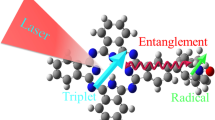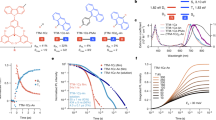Abstract
Quantum teleportation transfers the quantum state of a system over an arbitrary distance from one location to another through the agency of quantum entanglement. Because quantum teleportation is essential to many aspects of quantum information science, it is important to establish this phenomenon in molecular systems whose structures and properties can be tailored by synthesis. Here, we demonstrate electron spin state teleportation in an ensemble of covalent organic donor–acceptor–stable radical (D–A–R•) molecules. Following preparation of a specific electron spin state on R• in a magnetic field using a microwave pulse, photoexcitation of A results in the formation of an entangled electron spin pair D•+–A•−. The spontaneous ultrafast chemical reaction D•+–A•−–R• → D•+–A–R− constitutes the Bell state measurement step necessary to carry out spin state teleportation. Quantum state tomography of the R• and D•+ spin states using pulse electron paramagnetic resonance spectroscopy shows that the spin state of R• is teleported to D•+ with high fidelity.
This is a preview of subscription content, access via your institution
Access options
Access Nature and 54 other Nature Portfolio journals
Get Nature+, our best-value online-access subscription
$29.99 / 30 days
cancel any time
Subscribe to this journal
Receive 12 print issues and online access
$259.00 per year
only $21.58 per issue
Buy this article
- Purchase on Springer Link
- Instant access to full article PDF
Prices may be subject to local taxes which are calculated during checkout



Similar content being viewed by others
Data availability
The datasets generated and analysed in the current study are available from the corresponding author on reasonable request.
References
Pirandola, S., Eisert, J., Weedbrook, C., Furusawa, A. & Braunstein, S. L. Advances in quantum teleportation. Nature Photon. 9, 641–652 (2015).
Wootters, W. K. & Zurek, W. H. A single quantum cannot be cloned. Nature 299, 802–803 (1982).
Bennett, C. H. et al. Teleporting an unknown quantum state via dual classical and Einstein–Podolsky–Rosen channels. Phys. Rev. Lett. 70, 1895–1899 (1993).
Bouwmeester, D. et al. Experimental quantum teleportation. Nature 390, 575–579 (1997).
Boschi, D., Branca, S., De Martini, F., Hardy, L. & Popescu, S. Experimental realization of teleporting an unknown pure quantum state via dual classical and Einstein–Podolsky–Rosen channels. Phys. Rev. Lett. 80, 1121–1125 (1998).
Barrett, M. D. et al. Deterministic quantum teleportation of atomic qubits. Nature 429, 737–739 (2004).
Riebe, M. et al. Deterministic quantum teleportation with atoms. Nature 429, 734–737 (2004).
Sherson, J. F. et al. Quantum teleportation between light and matter. Nature 443, 557–560 (2006).
Steffen, L. et al. Deterministic quantum teleportation with feed-forward in a solid state system. Nature 500, 319–324 (2013).
Nielsen, M. A., Knill, E. & Laflamme, R. Complete quantum teleportation using nuclear magnetic resonance. Nature 396, 52–55 (1998).
Gao, W. B. et al. Quantum teleportation from a propagating photon to a solid-state spin qubit. Nat. Commun. 4, 2744 (2013).
Pfaff, W. et al. Unconditional quantum teleportation between distant solid-state quantum bits. Science 345, 532–535 (2014).
DiVincenzo, D. P. The physical implementation of quantum computation. Fortschritte der Physik 48, 771–783 (2000).
Thurnauer, M. C. & Norris, J. R. An electron spin echo phase shift observed in photosynthetic algae: possible evidence for dynamic radical pair interactions. Chem. Phys. Lett. 76, 557–561 (1980).
Sakaguchi, Y., Hayashi, H., Murai, H. & I’Haya, Y. J. CIDEP study of the photochemical reactions of carbonyl compounds showing the external magnetic field effect in a micelle. Chem. Phys. Lett. 110, 275–279 (1984).
Closs, G. L., Forbes, M. D. E. & Norris, J. R. Spin-polarized electron-paramagnetic resonance-spectra of radical pairs in micelles—observation of electron spin–spin interactions. J. Phys. Chem. 91, 3592–3599 (1987).
Hasharoni, K. et al. Mimicry of the radical pair and triplet states in photosynthetic reaction centers with a synthetic model. J. Am. Chem. Soc. 117, 8055–8056 (1995).
Carbonera, D. et al. EPR investigation of photoinduced radical pair formation and decay to a triplet state in a carotene−porphyrin−fullerene triad. J. Am. Chem. Soc. 120, 4398–4405 (1998).
Kobori, Y. et al. Primary charge-recombination in an artificial photosynthetic reaction center. Proc. Natl Acad. Sci. USA 102, 10017–10022 (2005).
Sheppard, D. M. W. et al. Millitesla magnetic field effects on the photocycle of an animal cryptochrome. Sci. Rep. 7, 42228 (2017).
Rodgers, C. T. & Hore, P. J. Chemical magnetoreception in birds: the radical pair mechanism. Proc. Natl Acad. Sci. USA 106, 353–360 (2008).
Carmieli, R., Thazhathveetil, A. K., Lewis, F. D. & Wasielewski, M. R. Photoselective DNA hairpin spin switches. J. Am. Chem. Soc. 135, 10970–10973 (2013).
Olshansky, J. H., Krzyaniak, M. D., Young, R. M. & Wasielewski, M. R. Photogenerated spin-entangled qubit (radical) pairs in DNA hairpins: observation of spin delocalization and coherence. J. Am. Chem. Soc. 141, 2152–2160 (2019).
Salikhov, K. M., Golbeck, J. H. & Stehlik, D. Quantum teleportation across a biological membrane by means of correlated spin pair dynamics in photosynthetic reaction centers. Appl. Magn. Reson. 31, 237–252 (2007).
Kandrashkin, Y. E. & Salikhov, K. M. Numerical simulation of quantum teleportation across biological membrane in photosynthetic reaction centers. Appl. Magn. Reson. 37, 549–566 (2010).
Volkov, M. Y. & Salikhov, K. M. Pulse protocols for quantum computing with electron spins as qubits. Appl. Magn. Reson. 41, 145–154 (2011).
Miura, T. & Wasielewski, M. R. Manipulating photogenerated radical ion pair lifetimes in wire-like molecules using microwave pulses: molecular spintronic gates. J. Am. Chem. Soc. 133, 2844–2847 (2011).
Kobr, L. et al. Fast photodriven electron spin coherence transfer: a quantum gate based on a spin exchange J-jump. J. Am. Chem. Soc. 134, 12430–12433 (2012).
Krzyaniak, M. D. et al. Fast photo-driven electron spin coherence transfer: the effect of electron-nuclear hyperfine coupling on coherence dephasing. J. Mater. Chem. C 3, 7962–7967 (2015).
Kelber, J. B. et al. Synthesis and investigation of donor–porphyrin–acceptor triads with long-lived photo-induced charge-separate states. Chem. Sci. 6, 6468–6481 (2015).
Nelson, J. N. et al. Zero quantum coherence in a series of covalent spin-correlated radical pairs. J. Phys. Chem. A 121, 2241–2252 (2017).
Nelson, J. N. et al. Effect of electron-nuclear hyperfine interactions on multiple-quantum coherences in photogenerated covalent radical (qubit) pairs. J. Phys. Chem. A 122, 9392–9402 (2018).
Jones, J. A. & Hore, P. J. Spin-selective reactions of radical pairs act as quantum measurements. Chem. Phys. Lett. 488, 90–93 (2010).
Rugg, B. K. et al. Spin-selective photoreduction of a stable radical within a covalent donor–acceptor–radical triad. J. Am. Chem. Soc. 139, 15660–15663 (2017).
Bell, J. S. On the Einstein–Poldolsky–Rosen paradox. Physics 1, 195–200 (1964).
Hamilton, W. O. & Pake, G. E. Linear antiferromagnetism in the organic free radical 1,3‐bisdiphenylene‐2‐phenyl allyl. J. Chem. Phys. 39, 2694–2697 (1963).
Schweiger, A. & Jeschke, G. Principles of Pulse Electron Paramagnetic Resonance 1st edn (Oxford Univ. Press, 2001).
Bao, X.-H. et al. Quantum teleportation between remote atomic-ensemble quantum memories. Proc. Natl Acad. Sci. USA 109, 20347–20351 (2012).
Grosshans, F. & Grangier, P. Quantum cloning and teleportation criteria for continuous quantum variables. Phys. Rev. A 64, 010301 (2001).
Stoll, S. & Schweiger, A. EasySpin, a comprehensive software package for spectral simulation and analysis in EPR. J. Magn. Reson. 178, 42–55 (2006).
Acknowledgements
This work was supported by the US National Science Foundation under grant no. CHE-1565925.
Author information
Authors and Affiliations
Contributions
M.R.W. conceived of the project. B.K.R. synthesized the molecules, performed EPR experiments and analysed the data. B.T.P. performed the transient optical spectroscopy and B.K.R. analysed the results with input from B.T.P., R.M.Y. and M.R.W. M.D.K. designed and implemented AWG upgrades to the Q-band EPR spectrometer, obtained EPR data and, along with B.K.R. and M.R.W., analysed the data. M.A.R. provided theory input for data analysis. B.K.R., M.D.K. and M.R.W. wrote the manuscript with input and edits from all authors.
Corresponding author
Ethics declarations
Competing interests
The authors declare no competing interests.
Additional information
Publisher’s note Springer Nature remains neutral with regard to jurisdictional claims in published maps and institutional affiliations.
Supplementary information
Supplementary Information
Supplementary Methods, Supplementary Characterization, Supplementary Data, Supplementary Figs. 1–7, Supplementary Tables 1–3.
Rights and permissions
About this article
Cite this article
Rugg, B.K., Krzyaniak, M.D., Phelan, B.T. et al. Photodriven quantum teleportation of an electron spin state in a covalent donor–acceptor–radical system. Nat. Chem. 11, 981–986 (2019). https://doi.org/10.1038/s41557-019-0332-8
Received:
Accepted:
Published:
Issue Date:
DOI: https://doi.org/10.1038/s41557-019-0332-8
This article is cited by
-
Features of the Primary Electron Spin Echo Signal for Spin-Correlated Radical Pairs
Applied Magnetic Resonance (2024)
-
Experimental realisation of multi-qubit gates using electron paramagnetic resonance
Nature Communications (2023)
-
Properties and applications of photoexcited chromophore–radical systems
Nature Reviews Chemistry (2023)
-
High-mobility semiconducting polymers with different spin ground states
Nature Communications (2022)
-
Triplet-radical spin entanglement: potential of molecular materials for high-temperature quantum information processing
NPG Asia Materials (2022)



